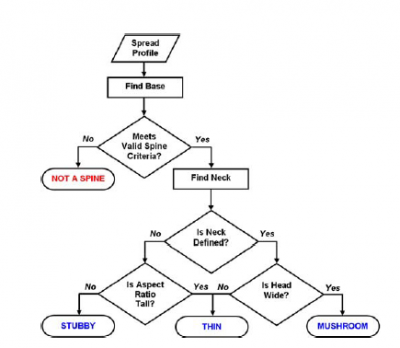DendriticSpineFeatures
From FarsightWiki
Dendritic Spine Features
Dendritic Spines

Image showing the four spine types and associated features. [1]

Flow of spine classification [2]
Tiny protrusions from the dendrite's membrane the spines affect the transmission properties of the signal that the dendrite receives from the synapse of an axon. The spine's two main anatomical regions are the the head and the neck. The region at the tip of the spine head is the post-synaptic densities (PSDs). [3] The types of spines can qualitatively be described as Stubby, Mushroom, Thin, or Branched (Bifurcated). [1] The Features can be summarized in the following table.
| Feature | Description | Equation |
|---|---|---|
| dh | Diameter of the head | measured from the radius |
| dn | Diameter of the neck | measured from the radius |
| L | side length * | measured from PDS to dendrite surface |
| Ln | Neck length | Measured bottom of head to dendrite surface |
| HNR | Head to Neck Ratio | 
|
| MSH | Maximum Spine Height | |
| MSW | Maximum Spine Width |
The classifications of spines can be determined by the following
| Type | Description | Equation |
|---|---|---|
| Thin | Tall spine with narrow neck | 
|
| Mushroom | Large Head | 
|
| Stubby | Short- no neck | 
|
| Branched | Multiple heads | h1...hi |
The spines can be classified in the manner described in the flowchart[2].
- the Side Length is also Spine Height or Distance to Surface (DTS) in some papers.
References
- ↑ 1.0 1.1 Harris, K. M., F. E. Jensen, et al. (1992). "Three-dimensional structure of dendritic spines and synapses in rat hippocampus (CA1) at postnatal day 15 and adult ages: implications for the maturation of synaptic physiology and long-term potentiation." J Neurosci 12(7): 2685-705.
- ↑ 2.0 2.1 Rodriguez A, Ehlenberger DB, Dickstein DL, Hof PR, Wearne SL (2008) Automated Three-Dimensional Detection and Shape Classification of Dendritic Spines from Fluorescence Microscopy Images. PLoS ONE 3(4): e1997. doi:10.1371/journal.pone.0001997
- ↑ http://en.wikipedia.org/wiki/Dendritic_spine